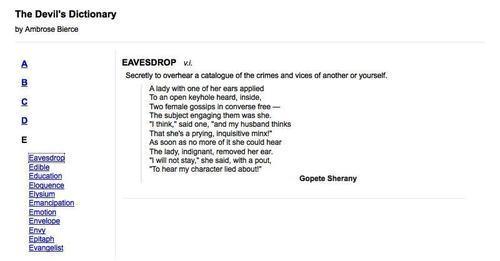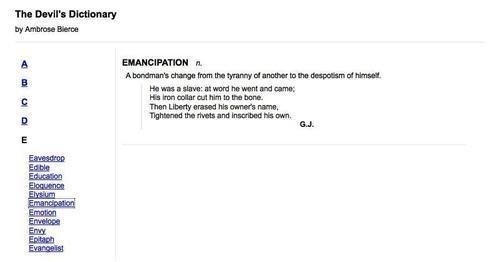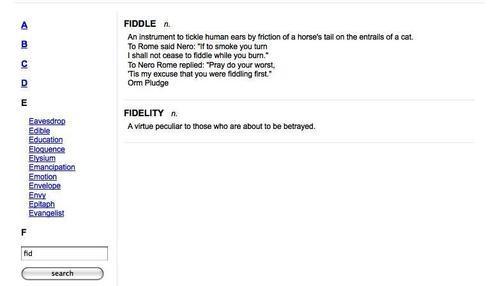Our examples to this point have focused on the task of retrieving static data files from the web server. However, the AJAX technique really comes into its own only when the server can dynamically
shape the data based on input from the browser. We're helped along by
jQuery in this task as well; all of the methods we've covered so far can
be modified so that data transfer becomes a two-way street.
Since
demonstrating these techniques requires interaction with the web server,
we'll need to use server-side code for the first time here. The
examples given will use the PHP
scripting language, which is very widely used as well as freely
available. We will not cover how to set up a web server with PHP here;
help on this can be found on the websites of Apache (http://apache.org/) or PHP (http://php.net/), or from your site's hosting company.
Performing a GET request
To illustrate the
communication between client and server, we'll write a script that only
sends one dictionary entry to the browser on each request. The entry
chosen will depend on a parameter sent from the browser. Our script will
pull its data from an internal data structure like this:
<?php
client and server communicationGET request, performing$entries = array(
'EAVESDROP' => array(
'part' => 'v.i.',
'definition' => 'Secretly to overhear a catalogue of the
crimes and vices of another or yourself.',
'quote' => array(
'A lady with one of her ears applied',
'To an open keyhole heard, inside,',
'Two female gossips in converse free —',
'The subject engaging them was she.',
'"I think," said one, "and my husband thinks',
'That she\'s a prying, inquisitive minx!"',
'As soon as no more of it she could hear',
'The lady, indignant, removed her ear.',
'"I will not stay," she said, with a pout,',
'"To hear my character lied about!"',
),
'author' => 'Gopete Sherany',
),
'EDIBLE' => array(
'part' => 'adj.',
'definition' => 'Good to eat, and wholesome to digest, as
a worm to a toad, a toad to a snake, a snake to a pig,
a pig to a man, and a man to a worm.',
),
'EDUCATION' => array(
'part' => 'n.',
'definition' => 'That which discloses to the wise and
disguises from the foolish their lack of
understanding.',
),
);
?>
<?php
$term = strtoupper($_REQUEST['term']);
if (isset($entries[$term])) {
$entry = $entries[$term];
$html = '<div class="entry">';
$html .= '<h3 class="term">';
$html .= $term;
$html .= '</h3>';
$html .= '<div class="part">';
$html .= $entry['part'];
$html .= '</div>';
$html .= '<div class="definition">';
$html .= $entry['definition'];
if (isset($entry['quote'])) {
client and server communicationGET request, performing$html .= '<div class="quote">';
foreach ($entry['quote'] as $line) {
$html .= '<div class="quote-line">'. $line .'</div>';
}
if (isset($entry['author'])) {
$html .= '<div class="quote-author">'. $entry['author']
.'</div>';
}
$html .= '</div>';
}
$html .= '</div>';
$html .= '</div>';
print($html);
}
?>
Now requests to this script, which we'll call e.php, will return the HTML snippet corresponding to the term that was sent in the GET parameters. For example, when accessing the script with e.php?term=eavesdrop, we get back:

Once again, we note the lack of formatting we saw with earlier HTML snippets, because CSS rules have not been applied.
Since we're showing how
data is passed to the server, we will use a different method to request
entries than the solitary buttons we've been relying on so far. Instead,
we'll present a list of links for each term, and cause a click on any
of them to load the corresponding definition. The HTML we'll add for
this looks like:
<div class="letter" id="letter-e">
<h3>E</h3>
<ul>
<li><a href="e.php?term=Eavesdrop">Eavesdrop</a></li>
<li><a href="e.php?term=Edible">Edible</a></li>
<li><a href="e.php?term=Education">Education</a></li>
<li><a href="e.php?term=Eloquence">Eloquence</a></li>
<li><a href="e.php?term=Elysium">Elysium</a></li>
<li><a href="e.php?term=Emancipation">Emancipation</a>
</li>
<li><a href="e.php?term=Emotion">Emotion</a></li>
<li><a href="e.php?term=Envelope">Envelope</a></li>
<li><a href="e.php?term=Envy">Envy</a></li>
<li><a href="e.php?term=Epitaph">Epitaph</a></li>
<li><a href="e.php?term=Evangelist">Evangelist</a></li>
</ul>
</div>
Now we need to get our JavaScript code to call the PHP script with the right parameters. We could do this with the normal .load() mechanism, appending the query string right to the URL and fetching data with addresses like e.php?term=eavesdrop directly. Instead, though, we can have jQuery construct the query string based on a map we provide to the $.get() function:
$(document).ready(function() {
$('#letter-e a').click(function() {
$.get('e.php', {'term': $(this).text()}, function(data) {
$('#dictionary').html(data);
});
return false;
});
});
Now that we have seen other
AJAX interfaces that jQuery provides, the operation of this function
seems familiar. The only difference is the second parameter, which
allows us to supply a map of keys and values that become part of the
query string. In this case, the key is always term but the value is taken from the text of each link. Now, clicking on the first link in the list causes its definition to appear:

All the links here have
addresses given, even though we are not using them in the code. This
provides an alternative method of navigating the information for users
who have JavaScript turned off or unavailable (a form of progressive enhancement). To prevent the links from being followed normally when clicked, the event handler has to return false.
Performing a POST request
HTTP requests using the POST
method are almost identical to those using GET. One of the most visible
differences is that GET places its arguments in the query string
portion of the URL, whereas POST requests do not. However, in AJAX
calls, even this distinction is invisible to the average user.
Generally, the only reason to choose one method over the other is to
conform to the norms of the server-side code, or to provide for large
amounts of transmitted data; GET has a more stringent limit. We have
coded our PHP example to cope equally well with either method, so we can
change from GET to POST simply by changing the jQuery function we call:
$(document).ready(function() {
$('#letter-e a').click(function() {
$.post('e.php', {'term': $(this).text()}, function(data) {
$('#dictionary').html(data);
});
return false;
});
});
The arguments are the same, and the request will now be made via POST. We can further simplify the code by using the .load() method, which uses POST by default when it is supplied with a map of arguments:
$(document).ready(function() {
$('#letter-e a').click(function() {
$('#dictionary').load('e.php', {'term': $(this).text()});
return false;
});
});
This cut-down version functions the same way when a link is clicked:

Serializing a form
Sending data to the server often involves the user filling out forms.
Rather than relying on the normal form submission mechanism, which will
load the response in the entire browser window, we can use jQuery's
AJAX toolkit to submit the form asynchronously and place the response
inside the current page.
To try this out, we'll need to construct a simple form:
<div class="letter" id="letter-f">
<h3>F</h3>
<form>
<input type="text" name="term" value="" id="term" />
<input type="submit" name="search" value="search"
id="search" />
</form>
</div>
This time we'll return a set of
entries from the PHP script by searching for the supplied search term
as a substring of a dictionary term. The data structure will be of the
same format as before, but the logic will be a bit different:
foreach ($entries as $term => $entry) {
if (strpos($term, strtoupper($_REQUEST['term']))
!== FALSE) {
$html = '<div class="entry">';
$html .= '<h3 class="term">';
$html .= $term;
$html .= '</h3>';
$html .= '<div class="part">';
$html .= $entry['part'];
$html .= '</div>';
$html .= '<div class="definition">';
$html .= $entry['definition'];
if (isset($entry['quote'])) {
foreach ($entry['quote'] as $line) {
$html .= '<div class="quote-line">'. $line .'</div>';
}
if (isset($entry['author'])) {
$html .= '<div class="quote-author">'.
$entry['author'] .'</div>';
}
}
$html .= '</div>';
$html .= '</div>';
print($html);
}
}
$(document).ready(function() {
$('#letter-f form').submit(function() {
$('#dictionary').load('f.php',
{'term': $('input[name="term"]').val()});
return false;
});
});
This code has the intended
effect, but searching for input fields by name and appending them to a
map one by one is cumbersome. In particular, this approach does not
scale well as the form becomes more complex. Fortunately, jQuery offers a
shortcut for this often-used idiom. The .serialize()
method acts on a jQuery object and translates the matched DOM elements
into a query string that can be passed along with an AJAX request. We
can generalize our submission handler as follows:
$(document).ready(function() {
client and server communicationform, constructing$('#letter-f form').submit(function() {
$.get('f.php', $(this).serialize(), function(data) {
$('#dictionary').html(data);
});
return false;
});
});
